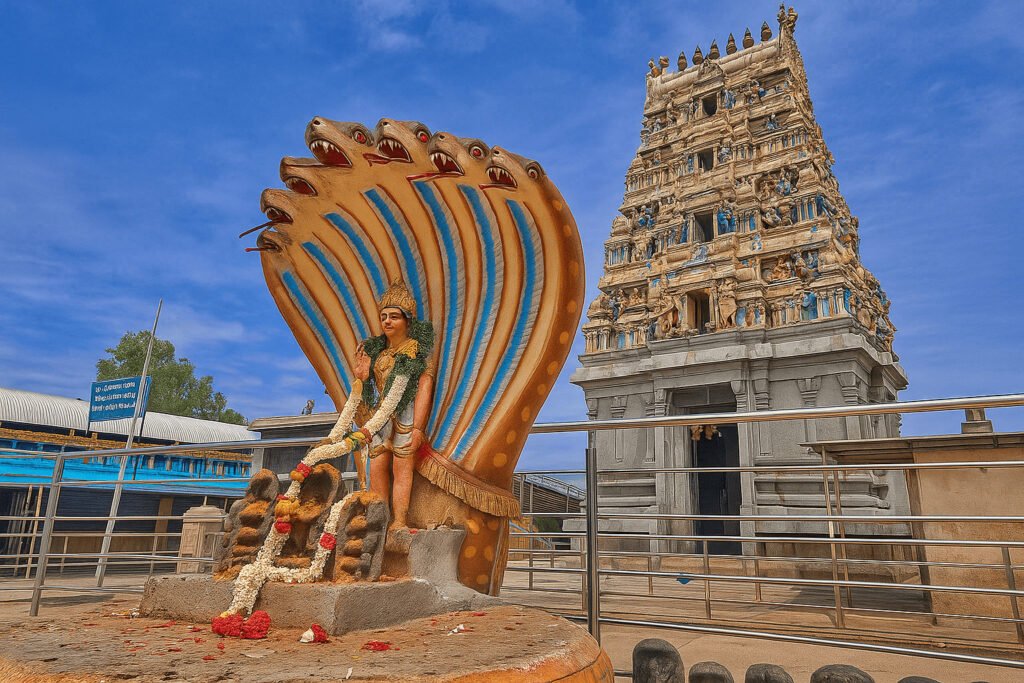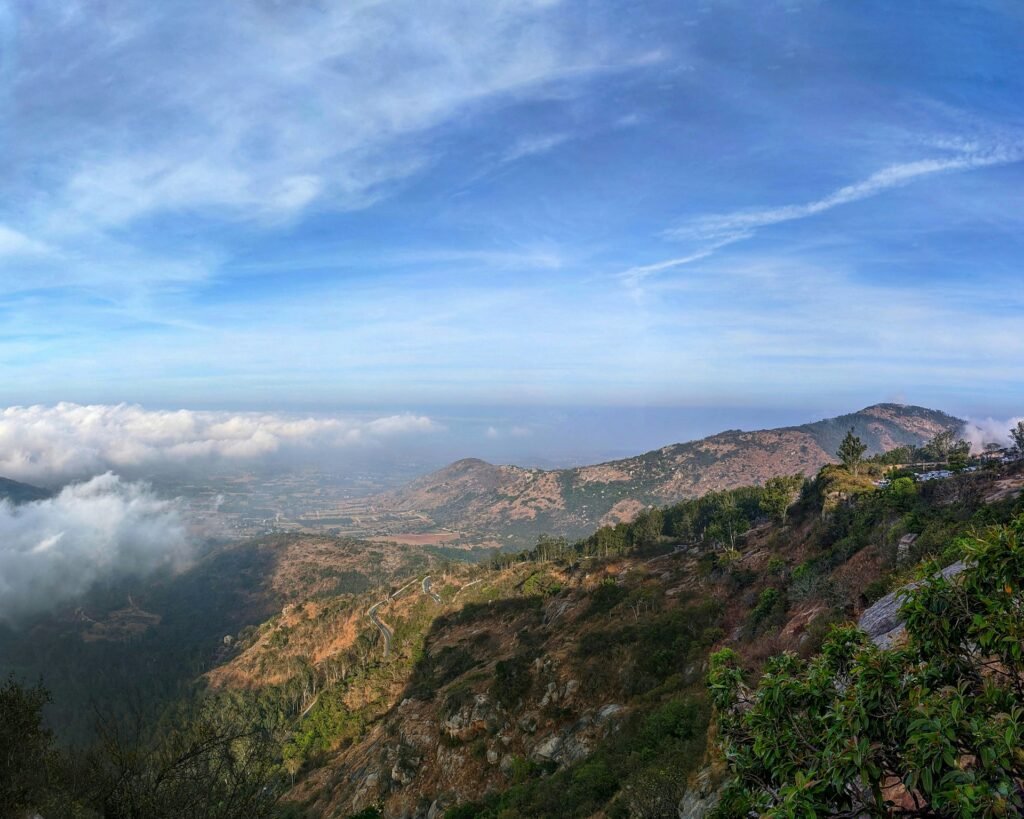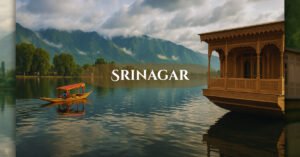Namaste Dosto!
If you are a South Indian, especially from Karnataka or Andhra, you must have heard about this one place where Lord Murugan/Kartikeya resides in a truly unique form. I am talking about the powerful and ancient Shri Ghati Subrahmanya Temple (or Ghati Subramanya as locals call it).
Honestly, every time I visit this temple, I feel a strange energy. It’s not just a temple; it’s a deep spiritual experience, especially for those who seek blessings for children or want to perform Sarpa Dosha Nivarana (serpent affliction remedy).
Many times, people from Bangalore just go for a quick half-day trip, but believe me, there is so much rich history and so many local secrets hidden here that you absolutely must know. That’s why I decided to write this complete guide for you—in the simplest, most honest way possible.
So, pack your bags (lightly, it’s a short trip!) and let’s dive into everything you need to know, from the thrilling myth to the exact bus routes and your ₹ budget! Ready for the darshan of a lifetime at Shri Ghati Subrahmanya Temple? Chalo, shuru karte hain!
Table of Contents
| Fact | Details |
|---|---|
| Name | Shri Ghati Subrahmanya Temple |
| Location | S.S. Ghati Post, Doddaballapur Taluk, Bengaluru Rural District, Karnataka 561203 |
| Distance from Bengaluru | Approx. 55-60 km |
| Principal Deities | Lord Subramanya (seven-hooded serpent form) & Lord Narasimha (via mirror) |
| Age / Historic Period | Over 600 years old (constructed by Ghorpade rulers) |
| Special Rituals | Sarpa Dosha Nivarana, Kuja Dosha, Ashlesha Bali |
| Typical Timings | 6:00 AM to ~8:30 PM (may vary) |
| Best Time to Visit | October to February (pleasant weather, fewer crowds) |
| Dress Code | Traditional modest clothing recommended |
| Nearest Railway Station | Makali Durga Railway Station (6-7 km) |

History & Mythology
Ancient Origins
The origins of Shri Ghati Subrahmanya Temple trace back over 600 years. According to temple records, it was first developed under the rule of the Sandur, who were patrons in parts of Karnataka, including the Bellary region.
Located near Tubagere, Doddaballapura (Bengaluru Rural District), it lies roughly 55-60 km from Bengaluru city.
The Myth and Legends
- One of the key legends holds that Lord (also known as Kartikeya or Murugan) performed tapas (penance) in serpent-form here before embarking on his divine mission.
- The place called “Ghati” is believed to be where he defeated the demon.
- A particularly rare feature: the main deity is a self-manifested (swayambhu) image of Lord Subramanya in serpent (seven-hooded snake) form, facing east, and behind him, Lord facing west. Devotees view Narasimha via a mirror placed in the sanctum.
- The site is also an important centre of naga (serpent) and Sarpa-Dosha rituals. Many devotees seeking relief from ‘snake curses’ or wishing for children install small snake idols here.
Here’s the Secret: You cannot see Lord Narasimha directly! The temple has strategically placed a massive mirror inside the Garbhagriha. You get the darshan of Lord Narasimha’s reflection through this mirror. It’s a truly brilliant and rare sight—getting the blessings of both Shiva’s son and Vishnu’s avatar at the same time!
Why It Matters
This temple isn’t just about devotion—it’s a convergence of mythology, iconography, serpent worship, and the regional cultural matrix of Karnataka. The uniqueness of dual deities in one stone carving, the connection to the naga clan, and the ancient penance myth give it a very special significance.
Temple Architecture & Spiritual Experience
Architectural Highlights
- Constructed in a regional Dravidian style, the temple features gopura (temple towers), pillared halls, and a sanctum that houses the self-manifested idol.
- The sanctum is particularly interesting: the front side shows Lord Subramanya in serpent form, while the mirror behind allows devotees to also see Lord Narasimha.
- The temple grounds are dotted with thousands of small snake idols (nagadevata offerings) placed by devotees—a visible testimony to the sanctity of the naga worship here.
The Spiritual Atmosphere
- When you step into the temple, the ambient quiet, the chanting of bhajans, the fragrance of incense, and the view of the twin deities create a layered spiritual experience—both ancient and vibrant.
- Many devotees describe a sense of releasing burdens—whether those are marital issues, health worries, or spiritual quests—here at this temple.
- Special rituals like Sarpa Dosha Nivarana, Kuja Dosha, Ashlesha Bali, and others are performed with focused devotion, making this a pilgrimage spot not just for casual visitors.
What to Notice & Do
- Take a moment to observe the mirror in the sanctum: it’s a clever architectural device allowing two deities to be seen in one gaze.
- Walk around the compound and note the numerous small snake idols—each tells a story of someone’s vow or gratitude.
- Pause at the pond or pushkarini (if present) near the temple—often used by devotees for purification or taking simple prasad.
- Respect the dress code: traditional modest attire is expected inside the sanctum area. (Men often wear dhoti/pancha; women wear saree or salwar suit)
Essential Visitor Information
If you are planning a trip, bookmark this section! This is the most important, quick-info part.
Shri Ghati Subrahmanya Temple Timings (Darshan & Pooja)
| Activity | Timings (Approx.) | Important Note |
| Temple Opening | 6:00 AM | Get here early to avoid the queue, especially on Tuesdays. |
| Abhishekam (Milk/Panchamrutha) | 8:30 AM – 9:00 AM | You can buy tickets on arrival. It is very auspicious! |
| Maha Mangalarathi | 10:30 AM and 8:30 PM | Timings are generally consistent, but check on major festival days. |
| Temple Closing | 9:00 PM | Timings are generally consistent but check on major festival days. |
| Standard Darshan | 6:00 AM – 9:00 PM | Free entry is always available. |
How to Reach Shri Ghati Subrahmanya Temple (Routes & Nearest Stops)
The temple is located in a lovely, peaceful area near the village of Tubagere, in Doddaballapura Taluk, about 60 km from Bangalore city centre. The drive is scenic, crossing green fields and small hills.
Nearest Airport
- Kempegowda International Airport, Bengaluru (BLR): This is the nearest and major airport, about 45-50 km away.
- Estimated Taxi Cost (BLR to Temple): ₹1,500 – ₹2,000 (one-way).
By Train (The Cheapest Route!)
- Nearest Railway Station: Makalidurga (MKLD). This is a small station, about 6 km from the temple.
- Main Hub: Doddaballapur Railway Station (DBU) is also close (about 10 km ).
- Tip: You can take a local passenger train from Bangalore City/Cantonment towards Guntakal and alight at either Makalidurga or Doddaballapur. From there, hire an auto-rickshaw (₹100–₹150) to the temple. Yeh hai sabse sasta tareeka!
By Bus (Local KSRTC/BMTC from Bangalore)
- This is the best option for budget travellers.
- Starting Point: Kempegowda Bus Station (Majestic) in Bangalore.
- Route: Take a KSRTC or BMTC bus going towards Doddaballapura. There are frequent buses (almost every 30 minutes).
- Final Stop: Get down at Doddaballapura Bus Stand. From there, you can easily catch a local bus or an auto-rickshaw to the temple (around 10 km ).
- Estimated Bus Cost (Bangalore to Doddaballapura): ₹50 – ₹100.
By Car/Taxi (The Easiest Drive)
- Route: The road is generally very good. Take NH44 (Airport Road) and turn towards Doddaballapura Road. The temple is well-signposted.
- GPS Coordinates: You can simply type Shri Ghati Subrahmanya Temple into Google Maps.
- Pro Tip: Combine your trip with Makalidurga Trek (if you are adventurous) or a morning visit to Nandi Hills, as they are nearby!
Local Secrets & Tips for the Route
- Combine your visit with nearby hill stations (e.g., ) or nature spots—makes for a richer one-day trip.
- If you’re coming from Odisha (your base in the Cuttack region), best to fly into Bengaluru, stay overnight, then drive to the temple the next morning.
- Parking is available near the temple complex—arrive early to secure a good spot if driving your own vehicle.
Food
- Local eateries and Udupi-style restaurants are available near Doddaballapura and en route to the temple. But facilities near the temple itself are modest. One reviewer noted: “The drive is wonderful … but there are no high-end pit stops for food and restrooms.”
- Tip: Carry bottled water and light snacks (especially if arriving early or in off-hours).
- After darshan, you can enjoy traditional Karnataka meals (rice, sambar, rasam) in small restaurants in the nearby town. Checking local listings like “Vrb Hotel and Restaurant” (Doddaballapura) helps.
Weather
- Being near the plains around Bengaluru, expect mild to warm weather. Summer months (March–May) can be hot (30-35 °C or more midday).
- After monsoon (July-September), the area is lush and greenery is at its best; roads are good but may have occasional wet patches.
- Winters (November to February) are pleasant for early morning visits (cool mornings around 18-20 °C) — ideal for comfortable darshan.
- Tip: If visiting early morning, carry a light jacket; evenings may drop in temperature.
- Avoid heavy rains if you plan for scenic detours or hill excursions.
Accommodation
- At the temple itself, there are limited lodging options; however, nearby towns and resorts offer comfortable stays. One accommodation listing for the temple shows contact details.
- For comfortable stays, consider:
- Mulberry Shades Bengaluru Nandi Hills, A Tribute Portfolio Resort (approx. 18 km away) — good for combining a temple visit with a resort stay.
- Spree Resort at Century Wintersun or other guest houses around Doddaballapura / Nandi Hills region.
- Booking Tip: If you plan a stay near the temple, book in advance during festival days or weekend visits, as rooms fill up.
- Budget Stays: Guest-houses in Doddaballapura or Tubagere may cost less; luxury resorts will cost more but offer amenities if you also want relaxation.
Best Time to Visit
- Ideal months: October to February — cool climate, lush countryside, pleasant mornings/ evenings.
- Monsoon season (July-September): Beautiful greenery, though occasional showers may affect travel comfort.
- Summer months (March-May): Hotter days, but mornings are still good; if you start early, you can visit before the midday heat.
- Festivals: The temple car festival (Brahmarathotsava) in Pushya Shuddha Shashti and Narasimha Jayanti attract large crowds. Visiting during festivals gives a rich experience, but expect bigger crowds.
- Weekdays vs Weekends: Weekdays are less crowded, and weekends attract more visitors from Bengaluru. One visitor noted a better experience avoiding Sundays/ Tuesdays.
October to February is the ideal time to visit Shri Ghati Subrahmanya Temple, when the weather is pleasant and perfect for spiritual travel.
👉 Read more: 10 Best Places to Visit in October in India
Your Budget Trip Plan: Costs in INR (2025 Estimates)
A one-day trip to Ghati Subramanya from Bangalore can be very affordable! Here is a rough breakdown of what you can expect to spend (excluding major poojas like Sarpa Samskara).
| Category | Cost Estimate (Low) | Cost Estimate (High) | Notes |
| Transport (Per Person) | ₹200 (Bus + Auto) | ₹1,500 (Round-trip Taxi) | From Bangalore (BLR) city centre. |
| Accommodation | ₹300 (Yatri Nivas/Lodge) | ₹2,000 (Resort/Hotel in D’ballapur) | Yatri Nivas near the temple offers affordable lodging. |
| Food & Water | ₹150 | ₹500 | Simple, filling meals (Annadana is available). |
| Darshan/Prasad | ₹0 (Free Darshan) | ₹50 (Special Darshan Ticket) | Special Darshan gets you quicker entry. |
| Simple Offerings | ₹50 (Flowers/Coconut) | ₹250 (Milk Abhishekam Ticket) | Milk Abhishekam is a must for many devotees. |
| Total (Per Person) | ₹700 (Budget traveler) | ₹4,250 (Comfort traveler) | Excludes major ritual costs. |
Nearby Attractions
- Nandi Hills: Just 25 km away. If you start very early for Ghati, you can cover Nandi Hills for a lovely sunrise and then come back down for the temple darshan (or vice-versa).
- Makalidurga: This is a famous hill trek with a ruined fort and a Shiva temple on top. It’s right next to the railway station. A great option if you are a nature lover!
- Doddaballapura Town – Explore local rural life, markets, small temples, and the quiet beauty of the surrounding countryside before or after visiting the main temple.
For longer itineraries, you might also explore other temples and historic spots around the Bengaluru rural district.

Travel Tips
- Start early: Arrive at the temple in the morning (by 7–8 AM) to avoid the rush and get a calm darshan experience.
- Footwear: Remove shoes before entering the inner sanctum; use the designated racks or guards.
- Dress modestly: Especially for the inner sanctum.
- Carry water & snacks: Though local eateries exist, they may be limited, especially if you visit early or late.
- Photography: Outside the sanctum, photography is usually allowed—respect any signs restricting use inside the garbhagriha.
- Offerings: If you are partaking in Sarpa Dosha or Naga rituals, plan — there are special procedures and offerings (which you may need to pre-book).
- Time Buffer: Allow time for travel from Bengaluru, parking, entry queue, as well as a break for refreshments; one-day trips are feasible, but better if you stay overnight nearby.
- Crowd Alert: During festivals and weekends, the temple grounds can get crowded. If you prefer a quieter visit, aim for an early weekday morning.
- Respect Local Customs: Avoid loud conversations in the sanctum, follow temple directions, and maintain the sanctity of the space.
- Footwear Rains: After monsoon showers, the access roads or temple steps may be slippery—wear good grip footwear and take extra caution.
- Combine with Nature: If time permits, add a nature trail or hilltop visit (such as Nandi Hills) to make your journey richer.
Before planning your temple visit, make sure you’re aware of local customs and etiquette to ensure a respectful trip.
👉 Read more: Essential Tips for Dos and Don’ts While Traveling
Final Thoughts
Visiting the Shri Ghati Subrahmanya Temple is more than just a temple stop—it’s a journey into legend, art, devotion, and serene nature. The rare confluence of deities, the mythology of serpents and penance, the lush surroundings, and the spiritual ambience all make it a memorable destination. Whether you’re coming from a tech city like Bengaluru or travelling from farther afield (like Odisha), planning will make the experience smoother and richer.
So, pack your camera, light refreshments, and an open mind. Arrive early, soak in the calm, explore the temple grounds, appreciate the unique twin-deity idol, and perhaps share your own story of blessing or discovery. And if you do visit, do share your experience with others.
Safe travels & happy darshan! 🙏
FAQs
-
Where is the Shri Ghati Subrahmanya Temple located?
The Shri Ghati Subrahmanya Temple is located in Doddaballapura Taluk, about 55–60 km from Bengaluru, in Karnataka. The full address is:
S.S. Ghati Post, Doddaballapura Taluk, Bengaluru Rural District – 561203. -
What is the best time to visit Shri Ghati Subrahmanya Temple?
The best months are October to February, when the weather is cool and comfortable. Avoid peak summer afternoons and rainy days if you prefer easier travel.
-
What is Shri Ghati Subrahmanya Temple famous for?
The temple is renowned for its self-manifested (Swayambhu) idol of Lord Subramanya in serpent form facing east, and Lord Narasimha facing west — both carved in one stone. It’s also famous for Sarpa Dosha Nivarana Poojas and its peaceful rural setting.
-
How much time is needed to cover Shri Ghati Subrahmanya Temple?
For a simple darshan, you will need about 1–2 hours. If you are performing an Abhishekam or a major pooja like Sarpa Samskara, it can take 3–4 hours easily. It’s best to plan for a full half-day trip to be safe.
-
Do I need an advance booking for Sarpa Dosha Pooja at Shri Ghati Subrahmanya Temple?
Generally, no. For the major group rituals like Samuhika Sarpa Samskara or Ashlesha Bali, you usually get the ticket on arrival at the temple counter in the morning. However, for a high-demand day like Ashlesha Nakshatra, it’s best to call the temple office in advance.



